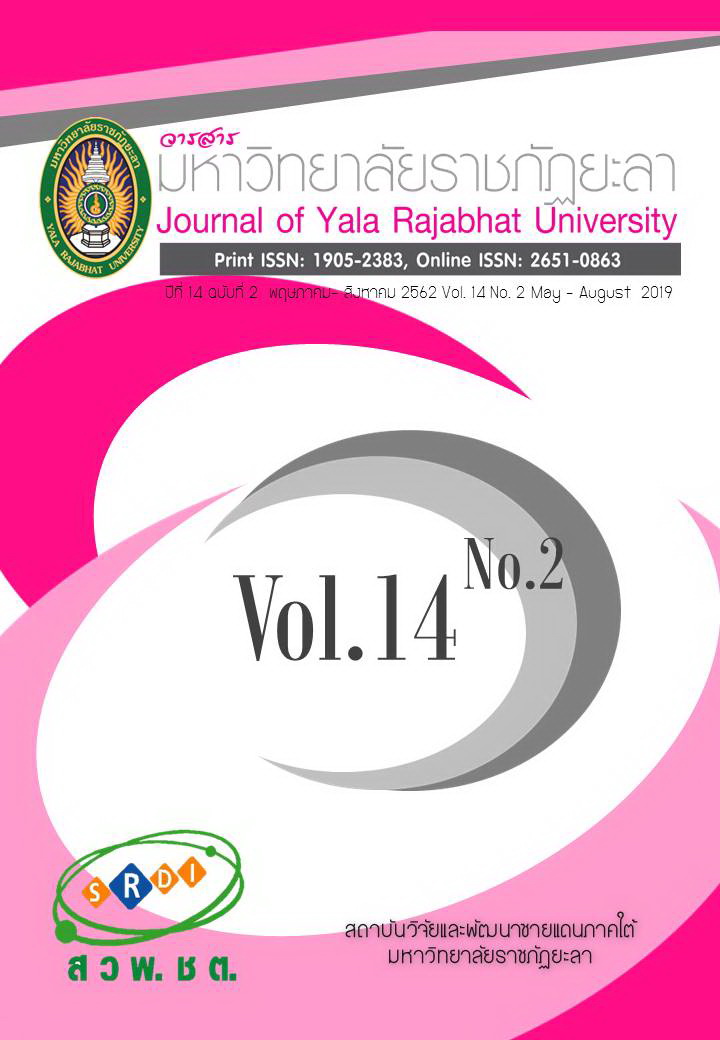อิทธิพลของบุคลิกภาพ ความสัมพันธ์ทางสังคมระหว่างผู้นำและผู้ตาม ต่อการมีภาวะผู้นำแบบสร้างแรงบันดาลใจของหัวหน้าภาควิชา ในมหาวิทยาลัยสงขลานครินทร์
Main Article Content
บทคัดย่อ
การวิจัยครั้งนี้มีวัตถุประสงค์เพื่อ 1) ศึกษาระดับการมีภาวะผู้นำแบบสร้างแรงบันดาลใจของหัวหน้าภาควิชา 2) ศึกษาอิทธิพลของบุคลิกภาพ และความสัมพันธ์ทางสังคมระหว่างผู้นำและผู้ตามที่มีต่อการมีภาวะผู้นำแบบสร้างแรงบันดาลใจของหัวหน้าภาควิชา และ 3) ศึกษาคุณลักษณะที่จำเป็นของการมีภาวะผู้นำแบบสร้างแรงบันดาลใจ กลุ่มตัวอย่างเป็นบุคลากรจากทุกภาควิชาในมหาวิทยาลัยสงขลานครินทร์ วิทยาเขตหาดใหญ่ จำนวน 214 คน เก็บข้อมูลโดยใช้แบบสอบถามออนไลน์ วิเคราะห์ข้อมูลโดยใช้สถิติ ความถี่ ร้อยละ ค่าเฉลี่ย ส่วนเบี่ยงเบนมาตรฐาน และการวิเคราะห์ถดถอยพหูคูณ ผลการศึกษาพบว่า จากมุมมองของผู้ตาม หัวหน้าภาควิชามีภาวะผู้นำแบบสร้างแรงบันดาลใจอยู่ในระดับเป็นบางเวลา ปัจจัยที่มีอิทธิพลต่อการมีภาวะผู้นำแบบสร้างแรงบันดาลใจพบว่า ปัจจัยที่สามารถพยากรณ์ภาวะผู้นำแบบสร้างแรงบันดาลใจอย่างมีนัยสำคัญทางสถิติที่ระดับ .01 ได้แก่ ความสัมพันธ์ทางสังคมระหว่างผู้นำและผู้ตาม บุคลิกภาพแบบเปิดตัว และ บุคลิกภาพแบบยึดมั่นในหลักการ โดยสามารถร่วมกันทำนายความผันแปรของภาวะผู้นำแบบสร้างแรงบันดาลใจได้ร้อยละ 60 และพบว่าคุณลักษณะที่ผู้ตามเห็นว่ามีความสำคัญต่อการมีภาวะผู้นำแบบสร้างแรงบันดาลใจของหัวหน้าภาควิชาคือ ความยุติธรรม ความเห็นอกเห็นใจ ความรอบรู้ในงาน ความกล้าตัดสินใจ และ ความซื่อสัตย์วางใจได้ ตามลำดับ
Article Details
บทความ ข้อมูล เนื้อหา รูปภาพ ฯลฯ ที่ได้รับการเผยแพร่ในวารสารมหาวิทยาลัยราชภัฏยะลานี้ ถือเป็นลิขสิทธิ์ของวารสารมหาวิทยาลัยราชภัฏยะลา หากบุคคลหรือหน่วยงานใดต้องการนำทั้งหมดหรือส่วนหนึ่งส่วนใดไปเผยแพร่ต่อหรือกระทำการใดๆ จะต้องได้รับอนุญาตเป็นลายลักษณ์อักษรจากวารสารมหาวิทยาลัยราชภัฏยะลาก่อนเท่านั้น
เอกสารอ้างอิง
2. Bass, B. M. & Avolio, B. J. (1996). The Multifactor Leadership Questionnaire. California: Mindgarden.
3. Bass, B. M. (1988). The Inspirational Processes of Leadership. Journal of Management Development, 7(5), 21-31.
4. Bernerth, J. B., Armenakis, A. A., Field, H. S., Giles, W. F., Walker, H. J. (2007). Leader–member social exchange (LMSX): Development and validation of a scale. Journal of Organizational Behavior, 28, 979-1003.
5. Bono, J. E. & Judge, T. A. (2004). Personality and Transformational and Transactional Leadership: A Meta-Analysis. Journal of Applied Psychology, 89, 901-910.
6. Bosco, F. A., Aguinis, H., Singh, K., Field, J. G. & Pierce, C. A. (2015). Correlational effect size benchmarks. Journal of Applied Psychology, 100, 431-449.
7. Chaisirithanya, K. (2017). School Administrator’s Charismatic Leadership Affecting School’s Effectiveness under the Secondary Educational Service Area Office 1. Veridian E-Journal Silapakorn University, 10(2), 62-78. (in Thai)
8. Conger, J. A. (1993). Max Weber's conceptualization of charismatic authority: Its influence on organizational research. The Leadership Quarterly, 4(3-4), 277-288.
9. Cronbach, L. J. (1990). Essentials of psychological testing. (5th ed.). New York: Harper Collins.
10. De Hoogh, A. H. B., Den Hartog, D. N. & Koopman, P. L. (2005). Linking the Big Five-Factors of personality to charismatic and transactional leadership; perceived dynamic work environment as a moderator. Journal of Organizational Behavior, 26(7), 839-865.
11. De Vries, R. E. (2012). Personality predictors of leadership styles and the self–other agreement problem. The Leadership Quarterly, 23, 809–821.
12. Gosling, S. D., Rentfrow, P. J. & Swann, W. B. (2003). A very brief measure of the Big-Five personality domains. Journal of Research in Personality, 37(6), 504-528.
13. House, R. J., Spangler, W. D. & Woycke, J. (1991). Personality and charisma in the U.S. presidency: A psychological theory of leader effectiveness. Administrative Science Quarterly, 36, 364–396.
14. House, R. J. (1977). A 1976 Theory of Charismatic Leadership. In J. G. Hunt and L. L. Larson (Eds.), Leadership: The Cutting Edge. Carbondale: Southern Illinois University Press.
15. Howell, J. M. & Shamir, B. (2005). The role of followers in the charismatic leadership process: Relationships and their consequences. Academy of Management Review, 30, 96–112.
16. Kao-ian, J. (2013). Relationship between leadership and administrative performance of educational administrators in three southern border provinces. Journal of Yala Rajabhat University, 8(1), 40-51. (in Thai)
17. Kananurak, N. (2011). Leadership role for producing professional employees. University of the Thai Chamber of Commerce Journal, 31(1), 123-133. (in Thai)
18. Meyer, J., Becker, T. & Van Dick, R. (2006). Social Identities and Commitments at Work: Toward an Integrative Model. Journal of Organizational Behavior, 27, 665-683.
19. Mumford, M. D. (2011). A hale farewell: The state of leadership research. Leadership Quarterly, 22, 1-7.
20. Peterson, C. & Seligman, M. E. P. (2004). Character Strengths and Virtues: A Handbook and Classification. New York: Oxford/American Psychological Association.
21. Planning Division of Prince of Songkla University. (2016). [Online]. Retrieved April 20, 2016, from: http://www.planning.psu.ac.th/. (in Thai)
22. Thai Journal Citation Index Center. (2017). [Online]. Retrieved December 1, 2017, from: http://www.kmutt.ac.th/jif/public_html/.


